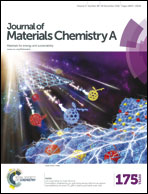Room temperature-processed inverted organic solar cells using high working-pressure-sputtered ZnO films†
Abstract
This study reports improved performance of inverted organic solar cells by using high working-pressure sputtered ZnO. Sputtering produces highly crystalline ZnO without the need for thermal annealing. However, photovoltaic devices fabricated by using sputtered ZnO have shown lower power conversion efficiencies than those made by using sol–gel ZnO. On the other hand, sol–gel ZnO limits the flexible application of inverted organic solar cells because of high-temperature annealing. Therefore, a new method of sputtering under high working pressure is developed. The power conversion efficiency of inverted organic solar cells fabricated using this high working-pressure-sputtered ZnO (η = 8.6%, VOC = 0.77 V, JSC = 15.6 mA cm−2, and FF = 0.72) is superior to that of conventional sol–gel ZnO-based devices (η = 7.8%, VOC = 0.73 V, JSC = 16.0 mA cm−2, and FF = 0.63). Furthermore, utilizing the low temperature process of sputtering, flexible application is successfully achieved using polyethylene terephthalate indium tin oxide films.


 Please wait while we load your content...
Please wait while we load your content...